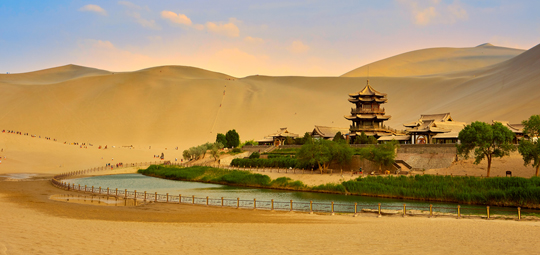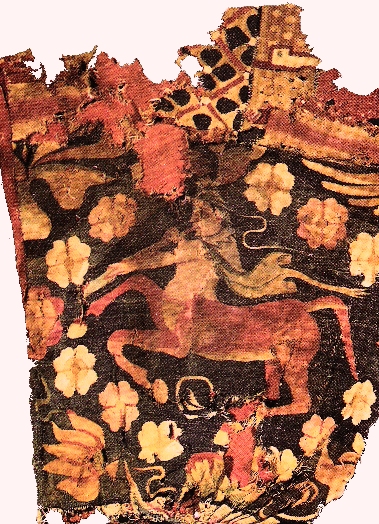Network of Silk Roads
Freiburg, Mar 22, 2021
The previously held notion that caravans transported luxury goods along a long trade route leading directly from China to Rome to sell them there at high prices is a myth. A research project by the historian Prof. Dr. Sitta von Reden from the Department of Ancient History takes a close look at what came to be known in the nineteenth century as the “Silk Road”: a complex network of exchange processes extending across large parts of the Asian and European continents.

Beyond the Silk Road: Researchers are studying how the economy in the years between 300 BC and 300 AD worked in all regions between China and Rome. Photo: Wang/stock.adobe.com
At the time of the Roman Empire, large numbers of goods flowed from China to Rome to supply the elite there – especially silk and other luxury articles. In 1877, the geographer Ferdinand von Richthofen coined the term “Silk Road” for this already long-known trade route. Using classical sources, he reconstructed the routes used to transport goods from the ancient Chinese capital of Chang’an to Rome: over the Taklamakan Desert and the Pamir Mountains to Central Asia and the Levant, then over Asia Minor and the eastern Mediterranean coast. “The ‘Silk Road’ is a colonial concept,” Sitta von Reden explains. “An implicit issue for von Richthofen was how to develop China as a colonial empire” This was based on the idea that the Mediterranean region was economically dependent on China: There was a demand for silk in Rome, and China met this demand. “What was also typically colonial is that all the spaces in between – the steppe, Iran, and other vast areas – remain in the dark in this interpretation,” adds the historian. “Von Richthofen was interested only in the Chinese and the Roman Empire. He saw all other civilizations as mere transit zones.”
Beyond the Silk Road
Von Reden’s research project seeks to get away from the road metaphor, regarding the trade relations instead as a network of exchange systems. “The ‘Silk Road’ is too simple,” von Reden explains. Historians today therefore always enclose the term in quotation marks. “Our question was: How can it be told differently? What was it really like?” says the Freiburg researcher. The name of her project, which is receiving funding from the European Research Council, is “Beyond the Silk Road.” The name was chosen deliberately, because the project does not just treat the classical “Silk Road” but also everything else that was a part of it. Von Reden’s team is studying how the economy worked in the various areas in the years between 300 BC and 300 AD. Their main focus is on studying the interimperial frontier regions, in other words, regions that never felt that they belonged to one or the other empire.
“Beyond the Silk Road” runs for five years and is the first project to attempt an interdisciplinary overview of the entire Eurasian region in antiquity. Specialists for the different regions are cooperating closely in von Reden’s team: a Sinologist, an archaeologist whose work is concentrated on Central Asia, an anthropologist responsible for the Central Asian region, a historian specialized in the eastern Mediterranean region, a historian who focuses on the Roman perspective, and an Indologist. The daily interplay between six fields of study is a methodological peculiarity. “Up to now, the history of the ‘Silk Road’ has been written by individual scholars who were experts in either Greco-Roman history or Sinology,” says von Reden. “But these two fields can’t achieve a overview over the entire region because they lack the necessary expertise to do so. I might be able to research the research literature on China, but I can’t interpret the Chinese source material.” By 2022, the team plans to complete a three-volume handbook summarizing the research from an interdisciplinary perspective. The first volume will treat the sources and the historiography of the individual regions. The second volume will explore how the economy worked in these empires and how goods were transported to the remote frontier regions. The third volume will deal with the frontier regions and the local exchange processes there.

Textiles made of silk and wool like this find from western China flowed in large numbers from China to Rome to supply the elite there. Silk and wool textiles from Sampul/Lop County/Xinjiang: https://en.wikipedia.org/wiki/Sampul_tapestry
Diplomatic Exchange of Gifts
The project seeks to shift the perspective from the centers to the frontier regions of the empires. The researchers hypothesize that the frontier zones were core regions for the exchange processes between empires. China did not exchange goods with Central Asia because there was a demand for them in Rome or because people in Chang’an wanted to ship, transport, or sell something. In the end, it was always the exchange processes on the frontiers that were key for the question of what goods moved from A to B. The reason why so much silk reached Rome, for example, had to do with the Xiongnu herding societies in the steppe bordering on China, von Reden explains. They demanded tributes for not invading the country and raiding. This included silk. The Chinese brought the ruling Khans silk by the bale on their diplomatic journeys to the Xiongnu, and the Xiongnu gave the Chinese horses in return. They also gave each other women. “That was not trade but a diplomatic exchange of gifts,” clarifies von Reden: “The Xiongnu received so much silk that they could have rolled it out and covered entire cities with it. But that was not so important to them.” Instead, they passed it on or exchanged it for other things they needed. In this way, silk made it to Central Asia and further into western regions, and it was passed through in various forms of exchange – partially through diplomacy, partially through trade, partially as booty.
The researchers are reconstructing such processes with the help of written and archaeological sources. “This makes our research challenging in various ways. In Rome und China there was historical writing. In other regions, working with the documentary material is a difficult process,” von Reden explains. The same goes for the state of research: There is already a lot of literature on the Roman economy that the researchers have to include in the study. “On the other hand, there’s no research at all on the economic structures in Central Asia, because up to now the region has been considered a transit zone on the ‘Silk Road.’ Hence, we first need to conduct fundamental research.”
A Reassessment of Frontier Regions
The researchers are also studying how the goods made it to the frontier regions in the first place in their project. “How did traders make it through difficult terrain with their camels? That’s a complicated question.” Usually border regions are not particularly densely populated, are located in the mountains or the desert – that’s why they’re frontier zones. Whereas large towns are usually in well-connected and fertile regions, frontier zones are usually in underdeveloped regions. The project is investigating the processes that led to the movement of goods and to the development of these border areas. The researchers are working with the empire-building theory: When empires expanded, troops came to the borders. In this way, the border regions were developed: Routes were surfaced and structures built to provide water and protection to travelers. “Our project shows that the main precondition for supplying frontier regions is changed economic structures,” von Reden explains. “To understand the exchange processes on the ‘Silk Road’ in the global context, we much therefore understand empire-building and processes in the frontier zones.” The Eastern Desert on the Red Sea in Egypt is such an example: “It is a highly arid zone in which people who were not born there can’t survive,” says von Reden. “You can’t farm there, and you can’t breed livestock – what it is above all is hot.” After the conquest of Egypt by Alexander the Great, the Ptolemies built the first permanent seaports there, but they were not self-sufficient. Then the Romans developed the desert. They mined and improved the infrastructure, built wells and forts to stay in along the way and maintained them. Soldiers defended the paths against enemy attacks, and ships supplied the seaports with food and other goods. This special protection and the improvement of the infrastructure was what opened the doors for trade in the Eastern Desert. Trade developed from southern India to Egypt and from there to Alexandria and Rome. This allowed great riches to reach Rome via various routes, for instance ivory from Africa and spices from Arabia.
India and Egypt are located beyond the overland routes of the “Silk Road” but were likewise connected to the Asian trade or exchange route via the sea. The development of the Eastern Desert was therefore necessary to make trade possible in the first place. State promotion of infrastructure was crucial for the emergence of trade even beyond the frontier regions. In continental Asia, for example, the Persians maintained a fully developed road network with water supply, stops, and milestones. The reason for this was not trade but the king’s diplomatic trips, troop movements, the transport of groups of workers, and the supply of garrisons. The empires maintained the infrastructure because of state interests, von Reden sums up: “Trade was not planned but was more of a byproduct. Trade could come when the infrastructure was there.”
Sarah Schwarzkopf

